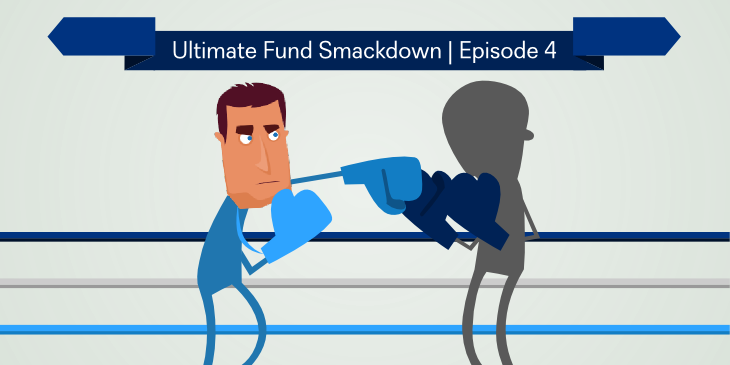There has been plenty of talk about whether actively managed mutual funds are worth the fees they charge. There are many people on either side of the argument. The proponents of active management argue that active managers can add value by selecting the best securities to own or by tactically shifting the asset allocation of the fund. The growing list of opponents argue that net of fees, investors are better off in a low-cost portfolio of ETFs or index funds.
To find the answer, we will put some of the largest and widely held Canadian mutual funds in the ring with a low-cost Modern Potfolio of ETFs and let them battle it out until one wins.
In our last post, the Modern ETF Portfolio easily beat its opponent, the Desjardins Canadian Equity Value Fund. For this post, we challenge the Mackenzie Cundill Value C which has a global equity focus.
Rules of Engagement
For each smackdown, we construct a low-cost, Modern ETF Portfolio that closely matches the historical average asset allocation of the incumbent mutual fund. We put the two investments against each other to see which one reigns supreme. Our assumptions are:
- The initial investment in each portfolio is $25,000
- Trading commissions of $9.95 to buy and sell ETFs, no fees for trading the mutual fund
- Dividends are reinvested at no cost
- The Modern ETF portfolio is rebalanced once per year
We will look at the past performance of the two investment options in terms of their Sharpe Ratio (portfolio returns minus the risk-free rate divided by the standard deviation of returns) over 3, 5, and 10-year periods to determine the winner.
Meet the Players
Mackenzie Cundill Value C has a 6% exposure to asset classes that are identified as “Other” by Morningstar. This makes building an ETF portfolio with the same asset allocation somewhat challenging. Because we have little visibility as to what “Other” assets are, we have ignored them for the purpose of this post. Instead, we have proportionately added the allocation to “Other” assets to the rest of asset classes.
Modern ETF Portfolio
Mackenzie Cundill Value C
Fund Expenses
0.13%
Fund Expenses
2.56%
Asset Allocation
Asset Allocation
Canadian Equities (XIC)
US Equities (XSP)
International Equities (ZDM)
Cash
Canadian Equities
US Equities
International Equities
Cash
Other
Let the Games Begin
First we look at how the two contenders performed in the past:
Modern ETF Portfolio’s past performance is based on a computer-generated back-test using the assumptions outlined below. For ETFs that do not have a long enough history, we use the underlying index’s total return minus the ETF’s annual MER.
$25,000 invested in the Modern ETF portfolio 10 years ago would be worth $42,510 at the end of May 2015, while $25,000 invested in Mackenzie Cundill Value C would be worth only $38,309, a difference of $4,201 or 17% of the original investment.
Below is a summary of annualized risk and return statistics for each of the contenders in the last 3, 5, and 10-year periods:
| Modern ETF Portfolio | vs. | Mackenzie Cundill Value Fund | ||||||
|---|---|---|---|---|---|---|---|---|
| Risk | Return | Sharpe Ratio | Winner1 | Winner1 | Sharpe Ratio | Return | Risk | |
| 6.21% | 16.55% | 2.37 | Round 1 3-year Performance |
2.10 | 18.23% | 7.76% | ||
| 9.25% | 10.99% | 1.08 | Round 2 5-year Performance |
0.62 | 8.97% | 14.13% | ||
| 11.60% | 5.46% | 0.37 | Round 3 10-year Performance |
0.25 | 4.36% | 13.57% | ||
1The winner of each round is the portfolio with the highest Sharpe Ratio.
The Champion is:

The Modern ETF Portfolio defeated the Mackenzie Cundill Value C by winning all three rounds by a wide margin!
The main reason the ETF portfolio beat the Mackenzie Cundill Value C fund is its lower fees. In fact, had the MER of the mutual fund been 1% instead of 2.56%, it would have outperformed the ETF portfolio. This shows that even though the fund managers are adding some value by making active decisions regarding asset allocation and security selection, the benefits are not enough to offset the high costs of the fund. This is the case for many mutual funds.
So what should you do as an investor? Stay away from expensive mutual funds. Keep your investment fees down by sticking to low-cost index funds and a disciplined rebalancing strategy. You can be sure your future self will appreciate it.
If you need more information on how you can implement a low-cost ETF portfolio, send us an email, and we will be glad to walk you through the steps.
